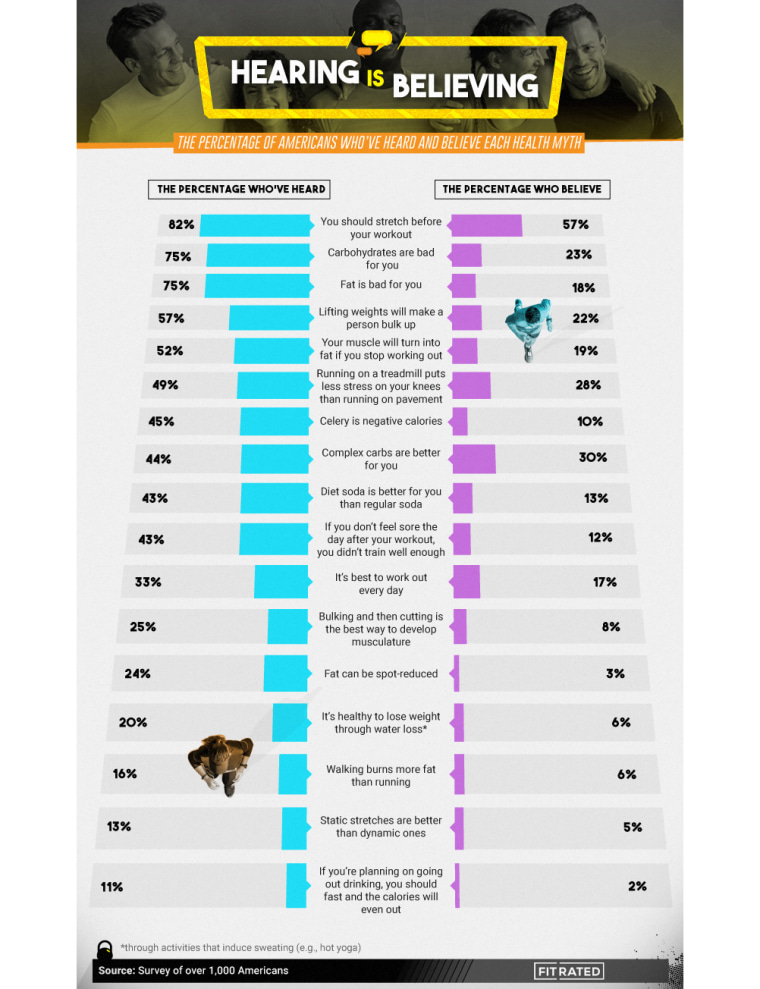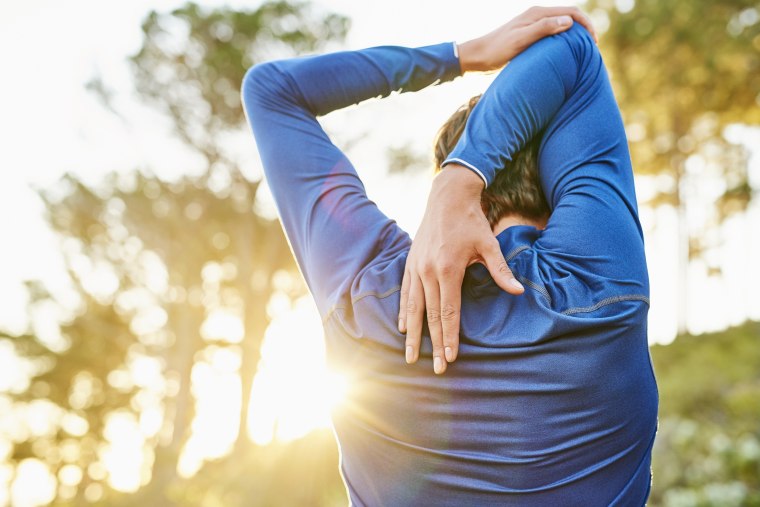The explosion of wellness as a mainstream trend has affected some positive change: healthier options at major restaurants, an influx of boutique fitness studios and a renewed interest in self-care among them.
But the invigorated interest in our health has also opened the floodgates for information – particularly around diet and fitness – that isn’t always the most reliable. There is so much information floating around about exercise, that it’s sometimes hard to discern fact from myth. And unfortunately for many of us, hearing is believing.
A survey conducted by FitRated asked 1,000 Americans about their gym activities and quizzed them on the most common health myths. It turns out, we may not be as informed as we think. From the importance of a pre-workout stretch to loving that post-workout soreness, fitness experts set the record straight on the most commonly believed fitness myths. School yourself on the truth now, so your gullibility doesn't impact your fitness progress moving forward.

Myth #1: You should stretch before your workout
The percentage who’ve heard of it: 82%
The percentage who believe it: 57%
The importance of a pre-workout stretch is the number one most-believed myth, with nearly 3 in 5 believers.
“The science of stretching can be a bit confusing for the average person as a Google deep dive will result in some pretty conflicting information. Studies have shown that the major benefit of stretching is maintaining or increasing range of motion through a joint. What about injury prevention and improved performance? The science is a little more undecided on those two things, with some studies showing gains and improvements, others none and even a few showing adverse effects,” says John Ford, certified exercise physiologist, and owner of JKF Fitness & Health (a boutique training company) in New York City.
“Stretching has historically been prescribed for tight muscles as a way to get the body to relax but recently the fitness industry has discovered that stretching a ‘cold’ body could have negative impacts,” adds Vanessa Huffman, Director of Teacher Training for Club Pilates. “Research has shown that when people are forcing their cool muscles to relax by overextending, it creates a surge of Glucocorticoids (stress hormones) that flood the body, which is the opposite reaction expected from people trying to relax a stiffened area."
But that doesn’t mean jumping right into your workout is the better option; instead keep the pre-workout warm up but change what it consists of. “Your routine should include a cardiovascular component to warm the body up and get blood flowing (anywhere from 5 to 15 minutes that results in at least a light sweat), followed by a sequence of dynamic exercises to prime and stretch the range of motions used in [exercise],” says Ford.
Myth #2: Running on a treadmill puts less stress on your knees than running on pavement
The percentage who’ve heard of it: 49%
The percentage who believe it: 28%
You may think logging your miles on a treadmill is less taxing on your joints than hitting the pavement – but that’s not entirely true.
“This is a myth and not a myth. In theory a treadmill can provide more give than say running on pavement. The science behind this being that a surface can help disperse the vertical forces of the body loaded during foot strike while running, thus reducing the impact on your knees,” says Ford. “However, science has shown a negligible difference in treadmill impact for knees versus say asphalt running. Additionally, while a treadmill might feel like less impact on your knees, the automated nature of the revolving belt has been shown to add additional stress on the Achilles tendon and other lower leg muscles, ligaments and tendons.”
“It's easy to see that perspective; a machine that is built for seamless running with a much softer landing pad has to be better for you than cold, hard, unrelenting concrete, right? Negative!" adds Josh Cox, Personal training manager for Anytime Fitness. "What's not being taken into account here are the subtle micro-adjustments your body makes when it is captain of its own ship that gets taken away once you launch your body onto a human conveyor belt and force it to bend to the treadmills will. Since these strains can be small but consistent they wear away at your knees similar to when your car wheel rubs on the inner wheel well ... the car still rolls but unless you take care of that friction it's going to lead to bigger problems later on.”
Both Ford and Cox agree that when it comes to treadmill and outdoor running, one isn’t better than the other, they’re just different. “Vary the surface you train on to best take advantage of the specific benefits each provides," says Ford. "Road or pavement running helps condition the body for the impact of running. Softer surfaces can improve strength, specifically with stabilizer muscles, as your body will have to work harder for forward and upward propulsion during the running motion, while also having to compensate for uneven surfaces and lateral give."
Myth #3: Lifting weights will bulk a person up
The percentage who’ve heard of it: 57%
The percentage who believe it: 22%
“This has got to be one of the worst fitness fallacies on the planet and it's not just because of the misinformation it presents but the fact that it steers so many people away from one of the most beneficial things you can do for yourself; lifting weights,” says Cox. “For a long time weight lifting was put in the spotlight by bodybuilders, strongmen and professional athletes determined to be the biggest and baddest on the block. It bred the longstanding misnomer that you lift heavy weights minimal times for size and strength and you lift little weight a lot of times to lose weight/lean out ... not true. At all.”
It’s important to dispel this myth because strength training is a vital component of any fitness routine. “Lifting weights regularly (and appropriately) will: improve your heart health, keep your tendons/joints/ligaments lubricated and feeling good, boost your metabolism/caloric burn, enhance your posture, minimize overall ‘life’ injuries, increase your energy, regulate your hormones and [make you stronger]!" says Cox. "It does all this because lifting weights taps into all of your bodies energy/movement systems while challenging it in a way that forces the response of all that was previously mentioned. What lifting weights won't do is give you unwanted bulkiness unless you are specifically training for that.”
Especially if you’re a woman.
“Women's hormones aren't conducive to ‘bulking up’ thus women have a greater handicap in putting on excess muscle mass. Essentially no one will EVER get ‘accidentally’ bulky. That's like being afraid to drive a car because you're afraid you'll find yourself in the middle of a NASCAR race," says Cox. "Don't deny yourself the benefits of 'driving' (read: lifting weights) because the irrational fear of participating in something that takes a long time to achieve extreme success at could 'accidentally' happen to you."
Myth #4: Your muscle will turn into fat if you stop working out
The percentage who’ve heard of it: 52%
The percentage who believe it: 19%
“This is a popular myth in part because of an optical illusion. If I transition from an active lifestyle of building mass to whatever an alternative lifestyle looks like, there is a transformation. The muscles get smaller and the body fat will probably rise depending on the diet. This leads most people to believe that in fact their muscle is turning into fat,” says Rob Delara, corporate head trainer at TITLE Boxing Club. “The real story is that muscle and fat are actually two totally different tissue systems with different functions. Muscle tissue is what gives you mass and what is constantly burning calories. The fat tissue is what gives you the ‘gut’ and is where excess energy is stored. Although energy is shared between the two systems, muscle and fat do not convert to one another. They simply move up and down on a spectrum independently and in most cases simultaneously.”
“The confusion for people probably comes in that when they are inactive, their muscle size and productivity decreases,” agrees Ford. “This results in less of a demand for ‘fuel’ or energy from food consumption. When your body has excess fuel from unused food its default is to convert it into long term storage, aka 'fat.' When you have an increased demand for storage your fat cells expand or grow larger and in some instances new ones are created.”
The takeaway: Muscle does not turn to fat. “However, neglected muscles and overeating to your body's energy demands will result in the growth of your fat cells. So make sure you keep the energy demands of your muscles high!” says Ford.
Myth #5: If you don’t feel sore the day after you work out, you didn’t train hard enough
The percentage who’ve heard of it: 43%
The percentage who believe it: 12%
Regardless of your level of physical fitness, there's a good chance you're familiar with that burning pain that can creep up after pushing yourself through a tough workout. "Most people will admit that being sore after working out is likely a sign that they need to be in better shape. People get confused when a strong and seemingly in shape person gets sore though, aren't they in good shape?" says Huffman.
The reason we find ourselves hobbling around the day after a workout lies in the two different types of muscles we call upon during exercise.
"Recent research shows that soreness is likely a result of having over-trained global muscles, which are the larger muscles in the body like the quadriceps and biceps. Global muscles are known for their ability to develop strength in addition to being called upon when the adrenaline kicks in during a workout (which is when they get the brunt of the damage resulting in soreness)," says Huffman. "Opposite to the global muscles are the supporting team, the local muscles which are responsible for supporting the mobility of the body's movement. Local muscles are the foundation of the 'core' and support the overall strength of the body through mobility resulting in a balanced and healthy unit."
When we find ourselves hobbling around in pain the day after workout, it's likely because we overworked those global muscles. "Next time you are tempted to work out to 'feel the burn,' consider the burn as a sign that your body may not be receiving the support it needs from the core and maybe it’s time to cross train with core development moves like the ones we love in Pilates," says Huffman.
GET MORE WORKOUT MOTIVATION
- How to work out in cold weather
- 'How I learned to love my body through yoga'
- Why exercising with a crowd supercharges your workout
- What it's like to start your day with a dance party
- The health benefits of losing just 5 percent of your body weight
Want more tips like these? NBC News BETTER is obsessed with finding easier, healthier and smarter ways to live. Sign up for our newsletter and follow us on Facebook, Twitter and Instagram.


